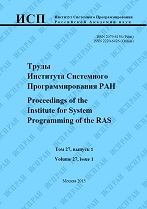|
This article is cited in 1 scientific paper (total in 1 paper)
Application of parallel algorithms for numerical simulation of quasi-one dimensional blood flow
A. N. Avdeeva, V. V. Puzikova
Federal state budgetary institution of higher professional education «Bauman Moscow State Technical University (National research university of technology)»
Abstract:
The main goal of modern hemodynamic simulation is the prediction of blood pressure in the arteries, as well as the study of the various factors complex effect on the cardiovascular system characteristics. Quasi-one dimensional models of blood flow through blood vessels are the most popular. They allow to model the blood flow in the entire vascular system. Since full-scale simulation of the cardiovascular system requires large computational costs, the problem of parallelizing computation is actual. In this paper, the efficiency study was carried out for parallel algorithms in the numerical simulation of blood flow in the quasi-one-dimensional approximation. For simplicity, we consider the problem of the blood flow simulation in a separate blood vessel. When constructing a parallel algorithm, the domain decomposition method was applied. In each subdomain, the problem at each time step splits into a hyperbolic and parabolic subproblems. To solve the hyperbolic subtask, an integro-interpolation method based on the MUSCL scheme is used. To integrate over time, the second order Runge-Kutta and Adams-Bashfort methods are applied. The Crank-Nicholson method is used to solve the parabolic subproblem. At the subdomains conjunctions, the interface conditions are non-linear systems with three unknowns. These systems are solved using the Newton method. The time-cost structure was obtained for solving the test problem in a serial mode using the AMD CodeAnalyst profiler. Computations were carried out at the cluster of the BMSTU "Applied Mathematics" FN-2 department. The computational results showed that the time gain achieved by using the MPI library does not exceed a few percent in comparison with the OpenMP technology usage. Taking into account the simplicity of parallelizing algorithms through OpenMP, we can choose this technology, but MPI usage allows to make the software package universal (it can work both on shared memory systems and on distributed memory systems).
Keywords:
MPI, OpenMP technology, MPI, quasi-one dimensional model, blood flow, domain decomposition method, parallel algorithm, cluster, MUSCL scheme, Godunov splitting.
Citation:
A. N. Avdeeva, V. V. Puzikova, “Application of parallel algorithms for numerical simulation of quasi-one dimensional blood flow”, Proceedings of ISP RAS, 30:2 (2018), 301–316
Linking options:
https://www.mathnet.ru/eng/tisp320 https://www.mathnet.ru/eng/tisp/v30/i2/p301
|

| Statistics & downloads: |
| Abstract page: | 203 | | Full-text PDF : | 72 | | References: | 35 |
|




 Contact us:
Contact us: Terms of Use
Terms of Use
 Registration to the website
Registration to the website Logotypes
Logotypes








 Citation in format
Citation in format 